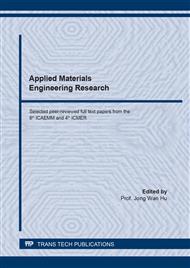[1]
J.M. Aberilla, A. Gallego-Schmid, A. Azapagic, Environmental sustainability of small-scale biomass power technologies for agricultural communities in developing countries, Renew. Energy. 141 (2019) 493–506.
DOI: 10.1016/j.renene.2019.04.036
Google Scholar
[2]
A. Acosta Tillán, M. Cabrera Martínez, J. Peña, Y. García Frómeta, Evaluación de la cáscara de arroz y la celulosa como aislante termo-acústico en sistema de placas de yeso, in: MESCYT (Ed.), XV Congr. Int. Investig. Científica (XV CIC), Santo Domingo, (2019).
Google Scholar
[3]
C. Buratti, E. Belloni, E. Lascaro, F. Merli, P. Ricciardi, Rice husk panels for building applications: Thermal, acoustic and environmental characterization and comparison with other innovative recycled waste materials, Constr. Build. Mater. 171 (2018) 338–349.
DOI: 10.1016/j.conbuildmat.2018.03.089
Google Scholar
[4]
M.A. Getahun, S.M. Shitote, Z.C. Abiero Gariy, Artificial neural network-based modelling approach for strength prediction of concrete incorporating agricultural and construction wastes, Constr. Build. Mater. 190 (2018) 517–525.
DOI: 10.1016/j.conbuildmat.2018.09.097
Google Scholar
[5]
A. Jindal, G.D. Ransinchung R.N., Behavioural study of pavement quality concrete containing construction, industrial and agricultural wastes, Int. J. Pavement Res. Technol. 11 (2018) 488–501.
DOI: 10.1016/j.ijprt.2018.03.007
Google Scholar
[6]
S. Liuzzi, S. Sanarica, P. Stefanizzi, Use of agro-wastes in building materials in the Mediterranean area: a review, Energy Procedia. 126 (2017) 242–249.
DOI: 10.1016/j.egypro.2017.08.147
Google Scholar
[7]
M. V. Madurwar, R. V. Ralegaonkar, S.A. Mandavgane, Application of agro-waste for sustainable construction materials: A review, Constr. Build. Mater. 38 (2013) 872–878.
DOI: 10.1016/j.conbuildmat.2012.09.011
Google Scholar
[8]
C. Maraveas, Production of sustainable construction materials using agro-wastes, Materials (Basel). 13 (2020).
DOI: 10.3390/ma13020262
Google Scholar
[9]
R. Muthuraj, C. Lacoste, P. Lacroix, A. Bergeret, Sustainable thermal insulation biocomposites from rice husk, wheat husk, wood fibers and textile waste fibers: Elaboration and performances evaluation, Ind. Crops Prod. 135 (2019) 238–245.
DOI: 10.1016/j.indcrop.2019.04.053
Google Scholar
[10]
O. Onuaguluchi, N. Banthia, Plant-based natural fibre reinforced cement composites: A review, Cem. Concr. Compos. 68 (2016) 96–108.
DOI: 10.1016/j.cemconcomp.2016.02.014
Google Scholar
[11]
A. Sabbatini, S. Lanari, C. Santulli, C. Pettinari, Use of almond shells and rice husk as fillers of poly (Methyl Methacrylate) (PMMA) composites, Materials (Basel). 10 (2017) 1–12.
DOI: 10.3390/ma10080872
Google Scholar


